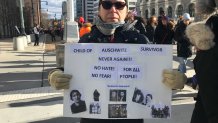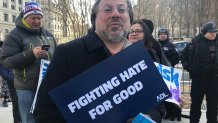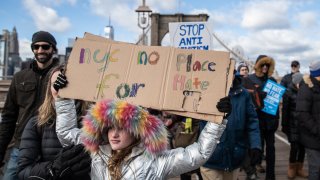In the nearly 30 years since tensions between the African American and Jewish communities exploded in riots in the Crown Heights section of Brooklyn, Rabbi Eli Cohen and Geoffrey Davis have established a friendship that the recent spate of anti-Semitic attacks has not dinted.
The African American, Caribbean American and Jewish communities that share Crown Heights are much closer today than they were then, said Cohen, the executive director of the Crown Heights Jewish Community Center.
“All the reports I’ve heard from police, from different experts in the field, this is not a community versus community kind of thing,” Cohen said. “If you want, that’s really the main difference from ’91. In ’90, ’91, there was a tension between different groups in the community. Here the community has really come to a place of greater harmony but there are pockets of humanity where not everyone got the message yet, so to speak.”
Attacks on ultra-Orthodox Jews in Jersey City, New Jersey, and Monsey, New York, in December have left the New York City metropolitan area shaken. In Jersey City, a man and woman, one of whom had been a follower of the Black Hebrew Israelite movement, are accused of storming the JC Kosher Supermarket. The hourlong standoff ended with their deaths along with those of Mindy Ferencz, 32, who ran the store with her husband, Miguel Douglas, 49, who worked at the store, and Moshe Deutsch, 24, a rabbinical student from Brooklyn who was a customer, authorities said.
Then an attacker, who authorities said had researched Adolf Hitler online, stabbed guests at a Hanukkah celebration at a rabbi’s home in Monsey, in Rockland County. One victim, 72-year-old Josef Neumann, was hospitalized with severe head injuries. The suspect, 37-year-old Grafton Thomas, has been indicted on attempted murder and multiple other charges.
The assaults highlighted a spike of anti-Semitic acts in Brooklyn, where Orthodox men have been punched, others have had eggs thrown at them and a brick was thrown through the window of a Hasidic girls school, the Jewish Telegraph Agency reported in November.
For some, the recent crimes play into a national climate of intolerance. They point to the shootings at two synagogues over the last two years that killed a dozen people and the march of white supremacists in Charlottesville, Virginia, in 2017, who chanted “Jews will not replace us!” among other slogans.
Among the thousands who participated in a “No Hate, No Fear” solidarity march over the Brooklyn Bridge at the beginning of January was 61-year-old Kathy Hoffstadter-Thal, the daughter of a survivor of the Auschwitz-Birkenau concentration and extermination camp who said that between 60 and 100 members of her mother’s family died during the Holocaust.
The world has been swept by such a climate of hate and scapegoating that the Edgewater, New Jersey, resident decided that she had to attend the rally.
“I don’t remember feeling fear in the 90s,” Hoffstadter-Thal said. “Today, I feel fear.”

Alan Klinger, a 63-year-old lawyer from New York City, said Americans need to put their differences behind them.
“Here in the United States, I always felt that this was a safe place to be, a place for all people and backgrounds, and something is happening, where it’s become much more polarized,” he said.

He points to the differences between the unrest in New York City in the 1990s and anti-Semitism today.
The Crown Heights riots broke out after a car driven by a Hasidic man — traveling in the convoy of the rabbi, or rebbe, of the Lubavitcher sect — jumped a curb and killed an 8-year-old African American boy, Gavin Cato, and injured his cousin, Angela Cato. Later a Jewish student from Australia, 29-year-old Yankel Rosenbaum, was stabbed and died in a hospital the next morning.
Today, across the country, white nationalists are unafraid to march in public.
“That’s when we know we have a problem,” Klinger said.
Cohen, of the Crown Heights Jewish Community Center, said that New York City had become more responsive to its different communities in the intervening years.
“I think the new generation of leadership is truly concerned and wants to have positive community relations,” he said.
Today, Cohen says he does not see a direct connection between what has happened in New York City and its suburbs with a broader culture of hate. The people who are committing local crimes do not appear to be inspired by national politics, he said.
“There are old prejudices and there are stereotypes that lead people to do things that really if they thought better they would not have,” he said. “So maybe that’s more of what’s going on right now.”
According to a report from the Center of the Study of Hate and Extremism at California State University, San Bernardino, there were 213 anti-Semitic hate crimes in New York City as of Dec. 25, 2019, compared to 189 in 2018.
Other large cities with significant Jewish populations reported increases, too. The center reported that anti-Semitic hate crimes reached an 18-year high in the country’s largest cities: New York, Los Angeles and Chicago.
In Los Angeles, there were 58 anti-Semitic crimes up from 43 in 2018. Chicago saw an increase to 19, up from 13 the year before.
"Hate crimes are getting more violent," said Brian Levin, the center's director.
The worst month as far as the number of incidents over the last decade was November 2016, he said. The worst day in 13 years was the day after the presidential election.
Davis, whose brother James was a city councilman who was shot to death at City Hall in 2003, said he thought the community was on top of things after the riots, starting different initiatives such as the One Crown Heights program.
“It was working,” he said, then as time went on, “We starting going about our daily lives.”
He and Cohen ramped up their efforts last summer, visiting students from pre-school to high school for conversations ranging from violence to bullying to stereotypes. He and Cohen recall a young girl who was wary of Cohen’s beard but soon enough was at his sleeve to tell him she was no longer afraid.
Davis would offer new after-school programs, one that revolved around performing arts for example, to complement the Jewish Children’s Museum and the Carlos Lezama Archives and Caribbean Cultural Center. Cohen said the community needed to redouble its efforts.
“I don’t think we’ve fallen asleep on the job,” Cohen said. “I think we’ve continued to develop those relationships in the community and so on and nurture them, but I think that this obviously — this wakes us up.”
Evan Bernstein, vice president in the Northeast Division of the Anti-Defamation League, was not in Crown Heights at the time but he believes that there is more understanding of each other at the top levels of the African American and Jewish communities. When there is a problem, people know who to speak to. The challenge now is to bring those connections to younger people in the community, he said.
“There hasn’t been a really deep change within these communities because there's not really — you’re not seeing 16-year-old Hasidic kids speaking to 16-year-old Caribbean or African American kids,” he said.
Bernstein said he thought gentrification, housing and other issues was eliciting anti-Semitism but did not know for certain.
“The analysis of why this is happening is purely speculative because we don’t have the right information from law enforcement,” he said. “We don’t don’t know the information, why perpetrators are actually doing this.”
The information is important because resources are finite and need to be directed where they can do the most good. He has been meeting with leaders in Brooklyn to look at restorative justice, to try to find out why young perpetrators are committing crimes and possibly to make it possible for them to volunteer in those communities.
Anti-Semitism, while it demands security of religious institutions, won’t be solved through policing, Bernstein said. The Anti-Defamation League is doubling its funding for its education program “No Place for Hate,” to bring it to twice as many schools in Brooklyn. The decision to provide $250,000 for the initial investment was a response to an increase in hate crimes targeting Jews in Brooklyn, the organization said in November at a press conference with the Brooklyn Borough President Eric Adams.
Since 1999, the program has helped to combat bias in more than 1,600 public and private schools across the country. In Brooklyn, the ADL reached 8,203 students in 22 schools. With the new funding, it will be working in as many as 40 schools, with an emphasis on public schools in Crown Heights and Williamsburg, where there are large Jewish populations.
On Thursday, 100 students marched through Crown Heights chanting, "Love, not Hate," shared a kosher pizza and met with a rabbi and others, according to a news outlet about the Chabad-Lubavitch community.
Bernstein traveled to Israel with 200 members of the Caribbean American community and in their conversations realized that there cultural norms that remained misunderstood — kashrut, or laws governing diet, for example, he said.
“Understanding people’s cultural norms can certainly go a long way with humanizing them,” he said.
The Rev. Gil Monrose, the pastor of Mount Zion Church of God 7th Day and faith director in the office of the Brooklyn borough president, visited Israel and Poland with Bernstein and they will return to Israel this year.
He was not in Crown Heights 30 years ago but says, “What happened in the ‘90s will not repeat itself in Brooklyn.”
He participated in the “No Hate, No Fear” march earlier this month and on Martin Luther King Jr. Day will help to restock the shelves at Masbia of Boro Park, a Kosher food pantry, in a show of unity. African American and Hasidic leaders from Jersey City are scheduled to join the event, which will focus too on sending relief supplies directly to Puerto Rico.
“We’re going to win this,” Monrose said.


